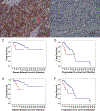Expression and mutational status of c-kit in thymic epithelial tumors
- PMID: 20651610
- PMCID: PMC7328988
- DOI: 10.1097/JTO.0b013e3181e96e30
Expression and mutational status of c-kit in thymic epithelial tumors
Abstract
Background: Overexpression of c-kit, a tyrosine kinase receptor protein encoded by the protooncogene kit, has been previously reported in thymic epithelial tumors and in other neoplasms such as gastrointestinal stromal tumors, myeloproliferative disorders, melanoma, and seminoma. Mutations in the kit gene have been related to response to imatinib in gastrointestinal stromal tumor and one case report of thymic carcinoma. We studied expression of c-kit in a large retrospective series of thymic epithelial malignancies and sequenced the whole gene in a subset of patients.
Methods: Thymic epithelial tumors from 120 patients (13 thymic carcinomas and 107 thymomas) were examined. Immunohistochemical staining with an antic-kit polyclonal antibody was performed on a tissue microarray. Mutation analyses of exons 1 to 20 were conducted by direct DNA sequencing of polymerase chain reaction products in eight thymic carcinomas, five thymomas, and one thymic carcinoma cell line.
Results: The percentage of c-kit positive cells was significantly higher in thymic carcinoma (46%) than in thymoma (4%). Decreased disease-related survival and progression-free survival were observed in c-kit positive tumors. No mutations were detected.
Conclusion: c-kit expression is strongly but not exclusively related to thymic carcinoma histotype, and it is of prognostic value. Mutations are very rare.
Conflict of interest statement
Disclosure: The authors have no financial conflicts of interest.
Figures

References
-
- Engels EA, Pfeiffer RM. Malignant thymoma in the United States: demographic patterns in incidence and associations with subsequent malignancies. Int J Cancer 2003;105:546–551. - PubMed
-
- Takeda S, Miyoshi S, Akashi A, et al. Clinical spectrum of primary mediastinal tumors: a comparison of adult and pediatric populations at a single Japanese institution. J Surg Oncol 2003;83:24–30. - PubMed
-
- Okumura M, Ohta M, Tateyama H, et al. The World Health Organization histologic classification system reflects the oncologic behavior of thymoma: a clinical study of 273 patients. Cancer 2002;94:624–632. - PubMed
-
- Edling CE, Hallberg B. c-Kit—a hematopoietic cell essential receptor tyrosine kinase. Int J Biochem Cell Biol 2007;39:1995–1998. - PubMed
Publication types
MeSH terms
Substances
Grants and funding
LinkOut - more resources
Full Text Sources
Medical

